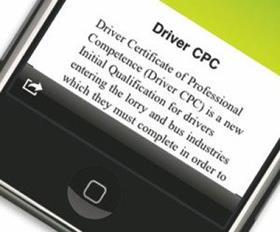
The government is to provide £34m to bring around 11,000 HGV drivers into the industry, both by attracting some of the 295,000 existing licence holders back into driving and funding training and testing of new entrants.
The 200 16-week ‘Skills Bootcamps in HGV Driving’ will be funded by the Department for Education and run by 17 training providers across the UK who have undergone a rigorous assessment process and can show evidence they have links with employers to provide the required work experience and full-time jobs. The scheme will run until November 2022 and as well as licence acquisition it will cover obtaining a Driver CPC and upskilling to ADR and petrochem tanker driving for returning drivers.
MT understands that the DfE had originally allocated £17m to train 5,000 drivers but upped the money available to £34m to allow the scheme to cover 11,000 drivers.
“HGV drivers are vital to keeping this country moving. It’s brilliant to see the first people with their hands on the steering wheel as they head towards new well-paid careers in the industry,” said education secretary Nadhim Zahawi. “To help even more people get the training they need to be road ready, and we’re expanding our HGV Skills Bootcamps to support up to 11,000 people to gain the skills they need to progress in the industry, and to help those with previous experience refresh their skills so they can get back on the road.”

The programme was welcomed by Mark Currie, CEO of the National Logistics Academy and Manchester training firm Mantra Learning, pictured, which has won a substantial share of the Skills Bootcamp funding.
“The Logistics Skills Network put a six-point plan together in July and one of our asks was a funded learning programme to train drivers,” Currie told MT. “We also made a plea to get existing licence holders back working.
“The enthusiasm from our employers has been huge. I know it is popular to bash government but we have seen more change in the funded part of our sector in the last five years than we have in the previous 15 or 20.”
The Logistics Skills Network (LSN) was formed in May 2020 as an independent trade association for vocational transport training providers, an initiative brought about by Skills for Logistics and Mantra Learning for the benefit of the whole haulage sector. It was intended to bring together organisations in the sector that can develop and share best practice, knowledge and resources and work closely with the government and the DVSA to ensure vocational training is properly represented.
The LSN told the government that there was an urgent need to clear the backlog of drivers waiting for HGV training and testing that had built up when the DVSA stopped testing due to Covid-19.
“We needed to catch up on driver training because we were only able to train for 18 weeks out of 60 so we lost around 45,000 licences in that period, which is the number that would normally be generated in a year,” said Currie. “The Skills Bootcamp came out of the idea that we need to train more people but also get people back into the sector who had left.”
The Skills Bootcamps were also welcomed by James Clifford, CEO of HGV training specialist HGVC, which has joined forces with labour agency Manpower and Logistics UK to form the Driver Academy Group (DAG) consortium that has secured funding to train and place 2,160 candidates.
"This is a very positive move and the appetite from the public is there," he said. "We had 2,600 enquiries over the weekend with no marketing by us."

DAG will train 800 new drivers to Category C or C+E with the remaining courses split among upgrading existing driver from C to C+E, ADR courses and improving 'soft' skills to enabled lapsed drivers to return to the workforce. Manpower will place drivers into jobs when they have completed their training.
Direct funding from government could be a lifeline for hundreds of small to medium size driver training companies which saw incomes virtually dry up in the pandemic.
“Specialist logistics training providers have struggled because they were not been allowed to train for 40 weeks and we didn’t get any rates relief during Covid,” said Currie. “The sector has been on its knees for two years and now it is expected to up its game and double capacity.
“This new funding is separate from the Apprenticeship Levy and is free of a lot of the restrictions that we would normally expect in the apprenticeship world so we should be able to get some blood flowing into the veins of the training sector.
“I would prefer it if we could do a pre-apprenticeship piece where drivers got their licence before they became an apprentice and I believe the Skills Bootcamp will enable us to do that.”
The National Logistics Academy was launched in July 2016 by Mantra to provide training, apprenticeships and workforce development to national logistics employers through a nationwide network of specialist logistics training providers.
“The LSN is very keen to promote improved professionalism of both drivers and driver trainers. The National Logistics Academy has a scheme of work that all instructors employed by our 30 subcontractors should operate to.
“Approved Driving Instructors for car driver training have to operate to a standard scheme of work and I believe we should have the same for HGV. It beggars belief that you have to go on a difficult ADI course to teach someone to drive a car and yet there isn’t a single standard for teaching someone how to drive a truck.”

Currie is also opposed to allowing car drivers to go straight to their Category C+E licence without first taking the Category C test. . “Creating more artic drivers shouldn’t be what the game is all about.” he said. “We desperately need more rigid vehicle drivers and there is also a big question mark about the road safety implications of skipping the Cat C test.”
The change will mean training providers need to find the money to acquire more artics as the balance in training shifts away from rigids.
“We will have to change our fleet profile if we are going straight to C+E,” said Currie. “Most trainers have four rigids for one tractor unit and now they will have to get to at least 50/50. Couple that with the need to comply with clean air zones in all the big cities or pay £60 a day and that is a big extra cost.
“While the government has addressed the lack of testing capacity we are going to have a massive shortage of HGV driving instructors and the right vehicles.”
Clifford agreed that while testing capacity in most areas has improved, shortages of vehicles could mean many new drivers would not be test-ready until spring next year. "The new direct access route from a B to a C+E licence has caused a lack of suitable C+E trucks," he said. "So we might be able to get drivers behind the wheel until March or April."
Studies have shown that as well as a shortfall of new drivers going through their HGV tests during the pandemic, the driver shortage is a result of qualified drivers leaving the industry after a few years, disillusioned with the mediocre pay, long hours, poor rest facilities and bad management practices.
The National Logistics Academy has carried out research among 250 licence holders to find out if they were still driving and if not why they quit.
“Around two thirds were not working in the transport sector,” said Currie. “This mirrors the national picture of a million people with HGV licences and the 330,000 who are actually driving professionally.

“A big reason was wages but others were conditions and respect. Contrary to a lot of thinking, Driver CPC was not a major factor. In my view the biggest reason for leaving is the poor relationships between drivers and traffic offices.
“There is a bullying chain where the customer tells the traffic office what they want and if they don’t get it they will use someone else. So the traffic office passes the responsibility on and tells the driver to go and do this crazy route even through it will means breaking the rules and probably the vehicle too.
“People can only take so much of that and a number of our key clients are working really hard on this.”
Some 3PLs have been pushing back against this pressure and have told customers their wage bill has increased by up to 40% and rates will have to improve to if they want the work doing. But large retailers in particular are still able to dictate terms.
“Some of the retailers are so powerful they have certain hauliers by the short and curlies,” said Currie. “They are still saying ‘this is the rate, take it or leave it’. For a long time one particular haulier was paying drivers £4 an hour less than other companies. When you get a big tranche of drivers on that low rate it changes the average across the industry.”
“They were employing and training a lot of new drivers only to see them move on after a couple of years because of the low wages, which seems a futile exercise.”
Wages have however increased significantly during the Covid-19 pandemic, and if this higher pay persists into 2022 Currie said it would represent an “opportunity to get these missing drivers back behind the wheel”.
Another area that employers have tried to address is the number of nights-out drivers are expected to do. “Anecdotally tramping is now less than 10% of haulage activity today,” said Currie.
But the other issue – respect for drivers – still needs addressing.
“This includes the problem of toilet facilities at back doors,” he said. “There is still this scenario of DC back doors with a queue of 100 trucks and the drivers have to use a bottle in the cab otherwise they would lose their place in the queue.”
The Skills Bootcamp refresher training for returning drivers will address a wide range of issues that may have led the individual to quit the job, including getting a Driver CPC, medicals, basic familiarisation with modern vehicles and tachos and a boost to confidence after an accident.
“Our programme will be tailored to each individual to enable them to feel confident getting back in a truck,” said Currie. “It will include a couple of days’ driving assessment and refresher training as well as working with an employer as a driver’s mate or driving the vehicle with an experienced driver.”
“Effectively they are getting an interview at the same time and after a week or so they will know if it is no longer the job they left or it still isn’t for them. It is giving everyone a fair crack of the whip.”











